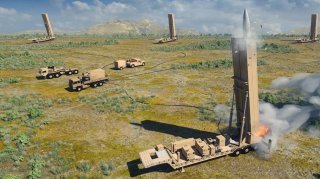Dark Eagle: The Army Wants a Mach 5 Hypersonic Missile That Can Strike from 1,725 Miles Away
Also known as "Dark Eagle," this is a medium-range, surface-to-surface hypersonic missile with two main parts – the missile itself, and a glide body. Lockheed Martin and Northrop Grumman are developing the missile component of the LRHW, while Dynetics is building the unpowered Common-Hypersonic Glide Body (C-HGB).
The different branches of the U.S. military often develop weapons independently. This leads to competition, whether it is necessary or not. But with the U.S. lagging behind China and Russia in the race to develop and field hypersonic weapons, the U.S. Army and Navy are setting aside any rivalries to work together on the Long-Range Hypersonic Weapon (LRHW).
Also known as "Dark Eagle," this is a medium-range, surface-to-surface hypersonic missile with two main parts – the missile itself, and a glide body. Lockheed Martin and Northrop Grumman are developing the missile component of the LRHW, while Dynetics is building the unpowered Common-Hypersonic Glide Body (C-HGB).
The LRHW has a reported range of 1,725 miles and can reach speeds of up to Mach 5. The glide body will be maneuverable in flight, making it difficult to detect and intercept.
According to a March report from the Congressional Research Service, "This land-based, truck-launched system is armed with hypersonic missiles that can travel well over 3,800 miles per hour. They can reach the top of the Earth's atmosphere and remain just beyond the range of air and missile defense systems until they are ready to strike, and by then it's too late to react."
Hypersonic Weapons: The U.S. Navy Is On Board
The Navy has expressed interest in adding the weapon to its Zumwalt-class destroyers, and possibly on Block V Virginia-class submarines. Plans to use the LRHW on guided-missile variants of Ohio-class subs were scuttled by funding delays and impending retirement.
The sea service's three Zumwalt-class destroyers would switch out their twin 155mm Advanced Gun Systems with 87-inch missile tubes that can each house three C-HGB hypersonic missiles.
Mach 5 Drama: Are There Problems?
The C-HGB has been successfully tested twice, in October 2017 and March 2020. The LRHW was slated to enter service with the Army in 2023, but last October the service said it would not be able to meet its deployment goals.
"The Army's November 2023 decision to revise its LRHW testing methodology seemingly suggests past testing difficulties might have been more significant than previously believed,” the CRS report added. “It was also noted that even if this dual path subcomponent testing regime proves successful, it could be a number of months before the LRHW becomes operational."
The government watchdog further suggested that based on the new approach, lawmakers should question how many successful LRHW flight tests will be required before the Army declares the missile operational, and how a potential delay of six or more months could affect the Army's LRHW program costs and fielding plans.
"Given concerns about how LRHW missile costs could influence LRHW inventories, policymakers might decide to further examine LRHW missile costs as well as quantities of LRHW missiles needed to support potential combat operations in various theaters of operations," CRS further noted.
The hypersonic race continues, and the Army and Navy are continuing to play catch-up.
Author Experience and Expertise: Peter Suciu
Peter Suciu is a Michigan-based writer. He has contributed to more than four dozen magazines, newspapers, and websites with over 3,200 published pieces over a twenty-year career in journalism. He regularly writes about military hardware, firearms history, cybersecurity, politics, and international affairs. Peter is also a Contributing Writer for Forbes and Clearance Jobs. You can follow him on Twitter: @PeterSuciu.
You can email the author: [email protected].


